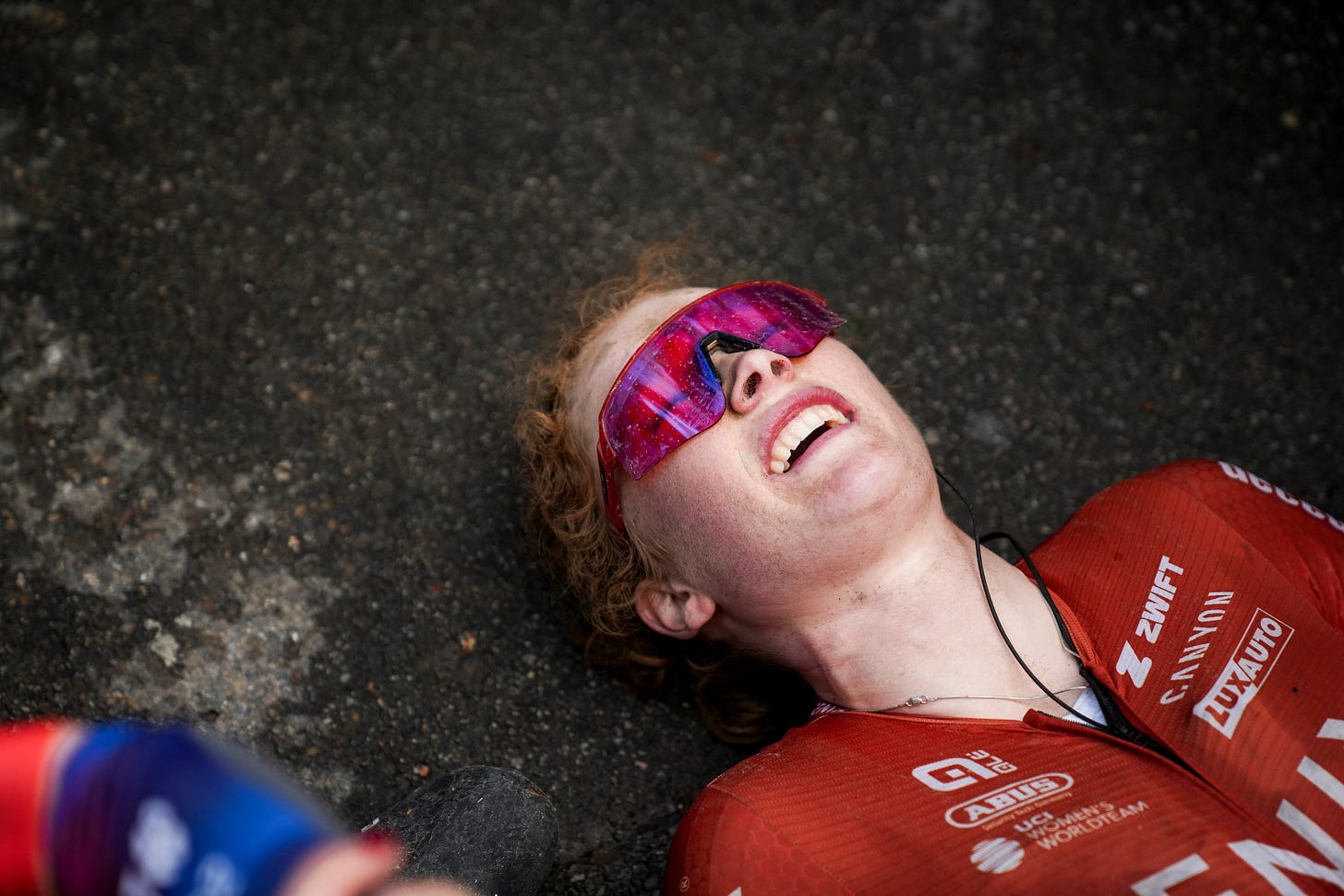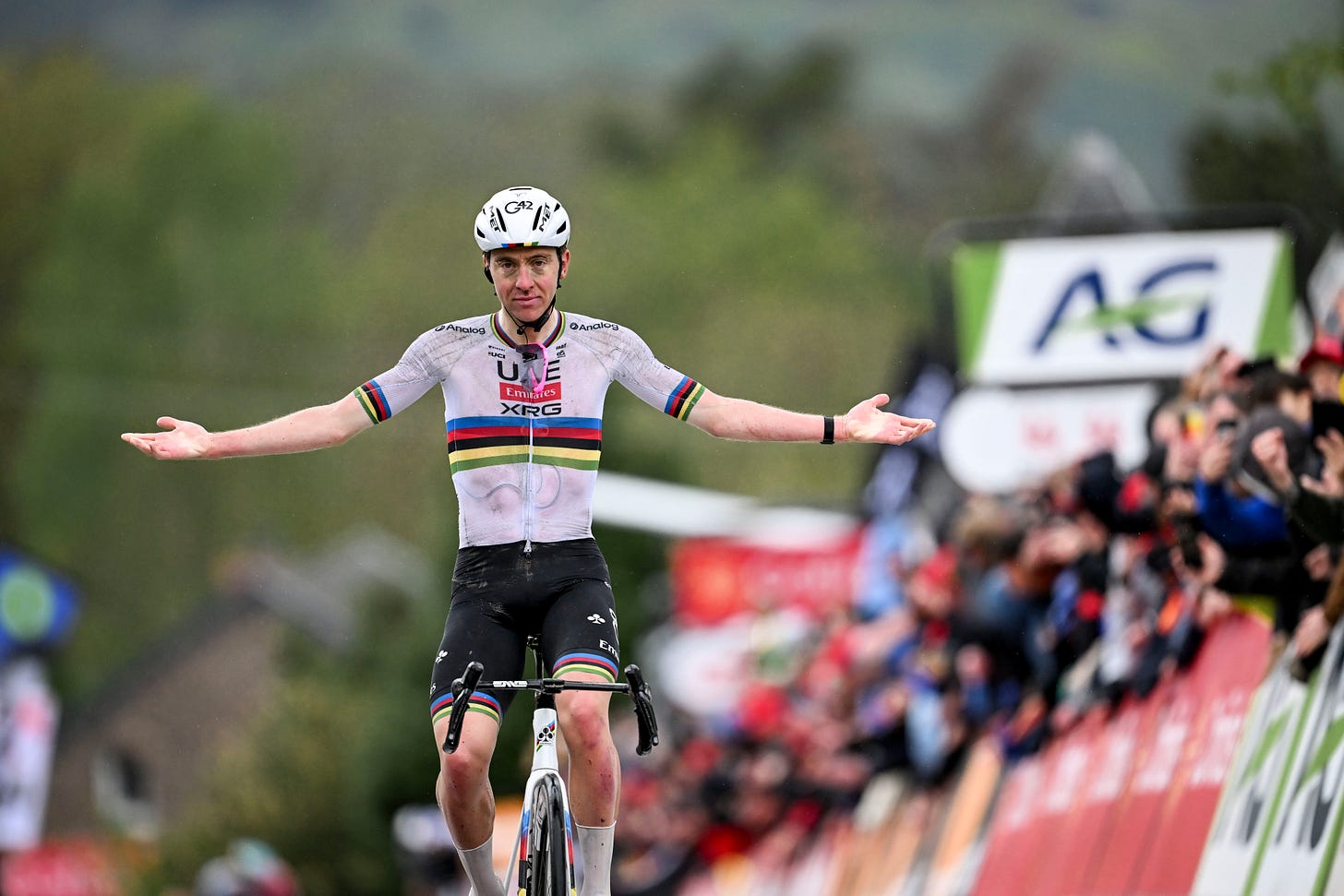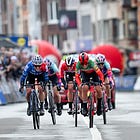The Spirit Is Willing and the Flèche Is Strong
The long-awaited Puck Pieterse one-day classics win is finally in the bag, and other stories from Ardennes Week
I’ve been predicting the big Puck Pieterse breakout classics win every week all season, and we finally got it at La Flèche Wallonne Femmes on Wednesday morning. The 22-year-old cyclocrosser stayed on Demi Vollering’s wheel as the race favorite set the pace, took all the right lines, hit all the right landmarks, and then creaked past right at the crest of the hill to take a massive, massive victory.
The Mur de Huy is one of those climbs that demands a lot from its champions. It’s just. So. Fucking. Steep. You could see this even in the men’s race, which was dominated by Tadej Pogačar and his army of three-lunged sickos, who made the climb look as easy as is possible. But no less a puncheur than Ben Healy tried to make his move and looked like he was pedaling up a mound of non-Newtonian fluid. Getting up the Mur quicky only takes a few minutes, but those few minutes can be agony.
From the moment Pieterse got out of her saddle for her decisive attack to the moment she crossed the finish line, only 29 seconds passed. But those 29 seconds were enough to send her straight to the asphalt after she stopped.
Vollering, who finished second, clearly wanted to offer Pieterse her congratulations, but by the time she arrived the winner was supine in the middle of the road. So Vollering just kind of sat down on the pavement next to her until she caught her breath. It was a fun moment.1
Of course, the key to any endurance sport, including cycling, is to make sure you’re properly fueled. Here’s Puck Pieterse on the podium at Amstel Gold on Sunday, carb-loading.
The relationship between cyclists and booze is a tricky one; this isn’t baseball, where you can tote around a beer gut all the live long day if you can spin a breaking ball. Every pound counts, as does every ounce of energy, so booze is out. Which is kind of a bummer. It’s one of many reasons I’m not a professional cyclist.
Every team has different rules for alcohol consumption, but the generally accepted practice is you can drink 1) sparingly 2) to celebrate a victory 3) especially if you’re offered booze on the podium.2 The Amstel Gold Race, as you’ve probably figured out, is sponsored by Amstel beer, so the podium finishers were all offered a pint of lager, and to be honest, it’d be rude to refuse.
Mischa Bredewold, the winner, and Pieterse, the third-place finisher, decided to race to the bottom. And Bredewold did OK, but Pieterse just destroyed her.
It got me thinking about how sports are kind of deterministic. Like, the most naturally talented cyclist in the world is probably not a professional bike racer, unless they grew up somewhere like Belgium or the Netherlands or Colombia. They’re probably involved in some other sport and never gave cycling a second thought. We are the product of our environments.
Pieterse’s beer chug is a little out of character for a cyclist, but this is an athlete who’s about to turn 23, and just so happens to have grown up in a country where cycling is one of the major sports. Which is to say that this is extremely Big Ten women’s soccer player behavior. What unites us is greater than what divides us.
What I want to know now is whether Pieterse can down the beer Marta Cavalli got for winning this race in 2022.
As the peloton came around to the Mur de Huy, color commentator Hannah Walker3 started talking about Annemiek van Vleuten. Van Vleuten is one of the greatest women’s cyclists of all time—she won absolutely everything4—and remained at the top of the sport into (relatively speaking) old age. In her final pro season, van Vleuten won the Giro at age 40.
But she never won La Flèche Wallonne. In 12 attempts, van Vleuten finished in the top 10 eight times and second three times. Four times she raced La Flèche Wallonne against Anna van der Breggen and four times van der Breggen not only beat van Vleuten, she won the race outright.
Near the end of her career, van Vleuten took a scientific approach to the Mur de Huy. It’s one of the few pieces of real estate that decides a major race every year, and is short enough that you can scout every inch of tarmac. So that’s what van Vleuten did. She mapped out every perfect line, where one side of the road was steeper than the other, for maximum efficiency. It never paid off for her.
But now, Walker said, van Vleuten is a performance coach at Fenix-Deceuninck, where one of her pupils is Puck Pieterse. And van Vleuten shared her notes with Pieterse, like Obi-Wan Kenobi giving Luke Skywalker his father’s lightsaber.
“Oh, that’s a nice story,” I thought, as Walker rolled through her anecdote and Vollering gradually rode the world off her wheel. “But Vollering seems like she’s got this under control.”
I don’t want to say that Pieterse sprang past Vollering, because she didn’t. I went back and looked—it took six seconds from the point Pieterse got out of her saddle to the point where she nosed ahead of Vollering.
But nose ahead she did, and once she passed Vollering, Vollering stayed passed.
The Mur doesn’t crest at the finish line; there’s about 75 meters of flat road between the top of the hill and the line.5 The Alto de l’Angliru—the most Mur de Huy-like big mountain on the world tour—is the same. In both cases, there’s a moment. It’s like an underwater explosion—the shockwave forms a bubble before the water pressure collapses everything back together again.
The hard climbing was over by this point, and if Pieterse was cracking Vollering had clearly cracked more. But there’s one last turnover of the wheels, one last effort, before the line. Thanks to van Vleuten’s tutelage, Pieterse had it. I don’t know if she had much more.
The men’s race was, well, slightly less dramatic. Pogačar took it. Look how thrilled he was to finish first.
Wednesday in Wallonia was rainy and muddy. Most riders wore vests6 or raincoats for most of the day. Mattias Skjelmose, who’d just shocked the world by beating Pogačar at Amstel Gold on Sunday, wiped out and DNF’d. You can see the toll on the winners’ faces. Pogačar with his raccoon dirt lines, Pieterse with crud just all over the place. She’s usually Jonas Vingegaard-level so-pale-I-can’t-believe-you-work-outdoors; when she hit the Mur she looked like Dick van Dyke in Mary Poppins.
The most interesting thing about Pogačar’s win were the glasses: Pink, for starters. I’m a big fan of loud-colored shades, so I approve. I’m also fascinated by the fact that he tucked them into his collar on the decisive climb rather than clipping them to his helmet, which is where riders put their glasses 99 percent of the time when they’re not using them.
The second-most interesting thing about Pogačar’s win was how orthodox it was. Like Milan-San Remo, this race is always always always won and lost after the start of the final climb. We get breakaway attempts every year, because nothing ventured, nothing gained, but it’s unusual to reach the final ascent of the Mur with fewer than a couple dozen riders.
And somewhat uncharacteristically, Pogačar didn’t diverge from that approach. Instead, in the valley between the Côte de Cherave and the Mur de Huy, 20-year-old UAE rider Jan Christen got on the front and drilled it to stretch out the peloton. When the Mur approached, Brandon McNulty got on the front.
I mostly write about McNulty in terms of his own ambitions as a time trialist and GC rider, but he is an incredible ally for Pogačar in a race like this: Powerful enough to drag the entire peloton across a flat section for ages, but sprightly enough to get up a hill like the Mur fast enough to put the other favorites under pressure. McNulty pulled until the favorites were into the final kilometer, at which point Christen got back on the front and ratcheted the tempo up again.
One by one, every threat to Pogačar fell away. Julian Alaphilippe couldn’t get up to temp. Tom Pidcock slipped a gear. Ben Healy actually managed to launch an attack with 500 meters to go. I think Healy might’ve actually gotten somewhere with this effort if he hadn’t royally fucked up his positioning lower down the hill.
Healy hit the Mur about sixth in line, but as McNulty pulled, for some reason, Healy got dropped back several places in the peloton, and only arrested his slide when the road was kicking up its steepest gradient. In order to even get back onto the wheel of Pogačar and Remco Evenepoel, he had to weave through traffic and outpace the leader for 500 meters on the steepest section of the road.
When Healy finally launched his attack, he’d been working for close to a minute to get back into a position where he could launch it. I thought Pieterse spun her wheels for ages, partially because she did, but also because I’d just watched absolutely nothing happen when Healy pulled the hyperdrive lever.7
Even after Healy kicked, I don’t think he ever got a legitimate full bike length lead on Pogačar. I’m also not entirely sure Pogačar noticed. Because once Healy cracked, Pogačar zoomed away, in the saddle, barely even breathing heavy. By the time he started really rocking his shoulders and hips, and looking over his shoulder to see if the attack stuck, Pogačar had put, I dunno, maybe 25 or 30 meters into Healy and the rest.
It was the expected result, for sure, but it was interesting because it was so by-the-book. And Pogačar is never by-the-book.
Neither the men’s nor women’s Liège-Bastogne-Liège has a full startlist posted, so I won’t go into too much detail prognosticating here. Except to say that while the climbing is similar in nature to what we saw at La Flèche Wallonne, the race is organized differently. It’s longer, and the finish is a flat sprint after a downhill.
In other words, I don’t think Pogačar is going to leave it to the last hill this time. Pogačar last year, and Remco Evenepoel the two years before that, won with fairly long solo breakaways. This is set up perfectly for Pogačar to attack from 30 kilometers out and ride off as the pursuit fails to get organized behind him and John Nash rolls over in his grave.
The other ending we see at Liège-Bastogne-Liège is a sprint from a group of, oh, between four and 10 riders? This is what we saw in the controversial 2020 edition, and in the women’s race last year, an instant classic won by Grace Brown.
Illness forced van der Breggen to abandon Amstel Gold and drop out of La Flèche Wallonne before the start, so I guess we’ll see if she’s up to competing at a race she won in 2017 and 2018. Her comeback has been a minor disappointment so far, if only because Pauline Ferrand-Prévot has already podiumed Strade Bianche and Ronde van Vlaanderen, and of course won Paris-Roubaix. Vollering is the favorite on this parcours until further notice, but after Paris-Roubaix I’m more interested than ever to see how far Ferrand-Prévot can actually push this.
Good sportsmanship is important
The all-time champ here is Sepp Kuss’s 12-second chug of sparkling wine at the 2023 Vuelta
I am 99% sure it was Hannah Walker
Except the Olympic road race; one of my first memories of watching professional women’s cycling was the road race in Rio in 2016. Van Vleuten crashed out of the lead in a horrifying end-over-end lockup that dropped her headfirst onto a curb. Not since Hermann Maier in Nagano have I been so certain I watched someone die live on TV at the Olympics.
Or maybe it just looks flat after you’ve watched these people pedal squares up a 15% gradient for three minutes.
I find most European sports slang charmingly weird at worst, but gilet just sucks.
Hell yeah, two Star Wars references in rapid succession








Both of those finish line photos are instant classics. A young phenom going deep and turning into a champion, and the reigning men’s champ looking like he’s about to say “are you not entertained?!” And barf everywhere. Great read, thanks!